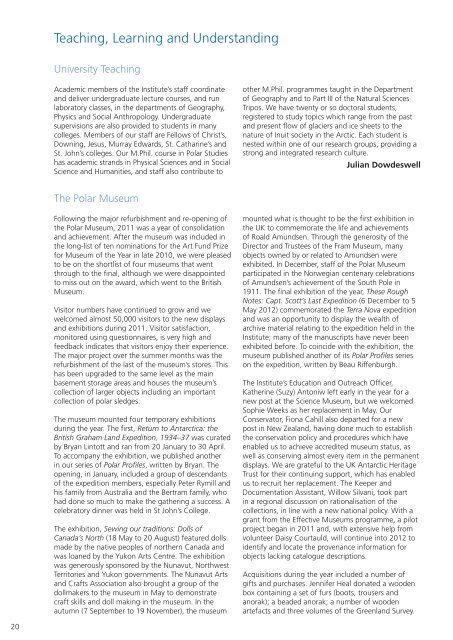PDF version of SPRI Review 2011 - Scott Polar Research Institute ...
PDF version of SPRI Review 2011 - Scott Polar Research Institute ...
PDF version of SPRI Review 2011 - Scott Polar Research Institute ...
You also want an ePaper? Increase the reach of your titles
YUMPU automatically turns print PDFs into web optimized ePapers that Google loves.
Teaching, Learning and Understanding<br />
University Teaching<br />
Academic members <strong>of</strong> the <strong>Institute</strong>’s staff coordinate<br />
and deliver undergraduate lecture courses, and run<br />
laboratory classes, in the departments <strong>of</strong> Geography,<br />
Physics and Social Anthropology. Undergraduate<br />
supervisions are also provided to students in many<br />
colleges. Members <strong>of</strong> our staff are Fellows <strong>of</strong> Christ’s,<br />
Downing, Jesus, Murray Edwards, St. Catharine’s and<br />
St. John’s colleges. Our M.Phil. course in <strong>Polar</strong> Studies<br />
has academic strands in Physical Sciences and in Social<br />
Science and Humanities, and staff also contribute to<br />
other M.Phil. programmes taught in the Department<br />
<strong>of</strong> Geography and to Part III <strong>of</strong> the Natural Sciences<br />
Tripos. We have twenty or so doctoral students,<br />
registered to study topics which range from the past<br />
and present flow <strong>of</strong> glaciers and ice sheets to the<br />
nature <strong>of</strong> Inuit society in the Arctic. Each student is<br />
nested within one <strong>of</strong> our research groups, providing a<br />
strong and integrated research culture.<br />
Julian Dowdeswell<br />
The <strong>Polar</strong> Museum<br />
Following the major refurbishment and re-opening <strong>of</strong><br />
the <strong>Polar</strong> Museum, <strong>2011</strong> was a year <strong>of</strong> consolidation<br />
and achievement. After the museum was included in<br />
the long-list <strong>of</strong> ten nominations for the Art Fund Prize<br />
for Museum <strong>of</strong> the Year in late 2010, we were pleased<br />
to be on the shortlist <strong>of</strong> four museums that went<br />
through to the final, although we were disappointed<br />
to miss out on the award, which went to the British<br />
Museum.<br />
Visitor numbers have continued to grow and we<br />
welcomed almost 50,000 visitors to the new displays<br />
and exhibitions during <strong>2011</strong>. Visitor satisfaction,<br />
monitored using questionnaires, is very high and<br />
feedback indicates that visitors enjoy their experience.<br />
The major project over the summer months was the<br />
refurbishment <strong>of</strong> the last <strong>of</strong> the museum’s stores. This<br />
has been upgraded to the same level as the main<br />
basement storage areas and houses the museum’s<br />
collection <strong>of</strong> larger objects including an important<br />
collection <strong>of</strong> polar sledges.<br />
The museum mounted four temporary exhibitions<br />
during the year. The first, Return to Antarctica: the<br />
British Graham Land Expedition, 1934–37 was curated<br />
by Bryan Lintott and ran from 20 January to 30 April.<br />
To accompany the exhibition, we published another<br />
in our series <strong>of</strong> <strong>Polar</strong> Pr<strong>of</strong>iles, written by Bryan. The<br />
opening, in January, included a group <strong>of</strong> descendants<br />
<strong>of</strong> the expedition members, especially Peter Rymill and<br />
his family from Australia and the Bertram family, who<br />
had done so much to make the gathering a success. A<br />
celebratory dinner was held in St John’s College.<br />
The exhibition, Sewing our traditions: Dolls <strong>of</strong><br />
Canada’s North (18 May to 20 August) featured dolls<br />
made by the native peoples <strong>of</strong> northern Canada and<br />
was loaned by the Yukon Arts Centre. The exhibition<br />
was generously sponsored by the Nunavut, Northwest<br />
Territories and Yukon governments. The Nunavut Arts<br />
and Crafts Association also brought a group <strong>of</strong> the<br />
dollmakers to the museum in May to demonstrate<br />
craft skills and doll making in the museum. In the<br />
autumn (7 September to 19 November), the museum<br />
mounted what is thought to be the first exhibition in<br />
the UK to commemorate the life and achievements<br />
<strong>of</strong> Roald Amundsen. Through the generosity <strong>of</strong> the<br />
Director and Trustees <strong>of</strong> the Fram Museum, many<br />
objects owned by or related to Amundsen were<br />
exhibited. In December, staff <strong>of</strong> the <strong>Polar</strong> Museum<br />
participated in the Norwegian centenary celebrations<br />
<strong>of</strong> Amundsen’s achievement <strong>of</strong> the South Pole in<br />
1911. The final exhibition <strong>of</strong> the year, These Rough<br />
Notes: Capt. <strong>Scott</strong>’s Last Expedition (6 December to 5<br />
May 2012) commemorated the Terra Nova expedition<br />
and was an opportunity to display the wealth <strong>of</strong><br />
archive material relating to the expedition held in the<br />
<strong>Institute</strong>; many <strong>of</strong> the manuscripts have never been<br />
exhibited before. To coincide with the exhibition, the<br />
museum published another <strong>of</strong> its <strong>Polar</strong> Pr<strong>of</strong>iles series<br />
on the expedition, written by Beau Riffenburgh.<br />
The <strong>Institute</strong>’s Education and Outreach Officer,<br />
Katherine (Suzy) Antoniw left early in the year for a<br />
new post at the Science Museum, but we welcomed<br />
Sophie Weeks as her replacement in May. Our<br />
Conservator, Fiona Cahill also departed for a new<br />
post in New Zealand, having done much to establish<br />
the conservation policy and procedures which have<br />
enabled us to achieve accredited museum status, as<br />
well as conserving almost every item in the permanent<br />
displays. We are grateful to the UK Antarctic Heritage<br />
Trust for their continuing support, which has enabled<br />
us to recruit her replacement. The Keeper and<br />
Documentation Assistant, Willow Silvani, took part<br />
in a regional discussion on rationalisation <strong>of</strong> the<br />
collections, in line with a new national policy. With a<br />
grant from the Effective Museums programme, a pilot<br />
project began in <strong>2011</strong> and, with extensive help from<br />
volunteer Daisy Courtauld, will continue into 2012 to<br />
identify and locate the provenance information for<br />
objects lacking catalogue descriptions.<br />
Acquisitions during the year included a number <strong>of</strong><br />
gifts and purchases. Jennifer Heal donated a wooden<br />
box containing a set <strong>of</strong> furs (boots, trousers and<br />
anorak); a beaded anorak; a number <strong>of</strong> wooden<br />
artefacts and three volumes <strong>of</strong> the Greenland Survey.<br />
20








